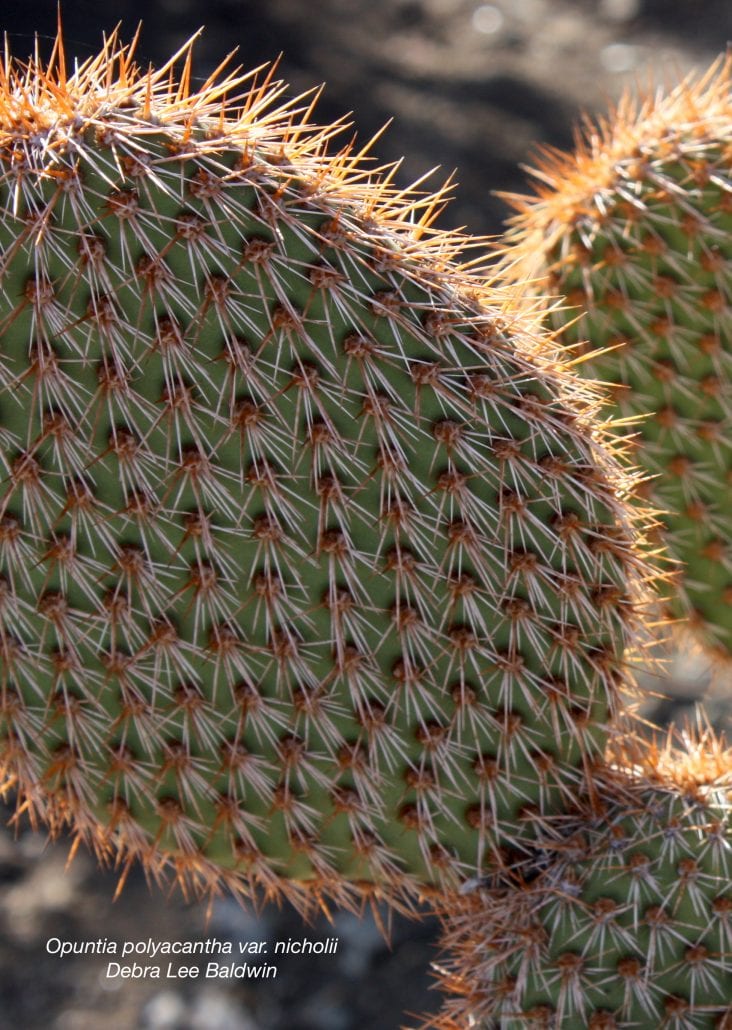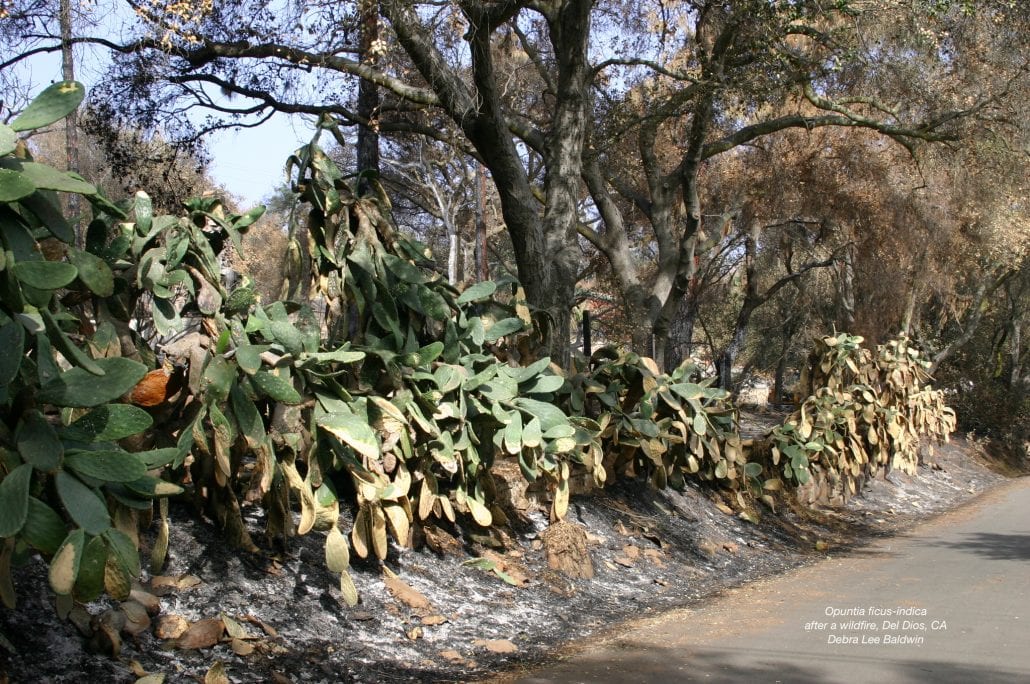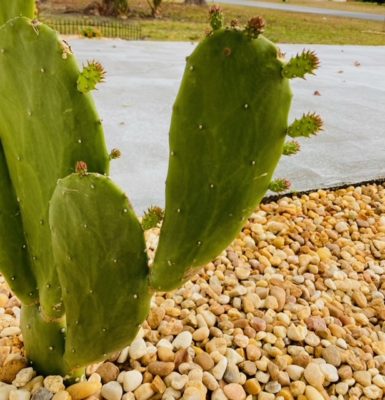
Why Grow Paddle Cacti? 16 Reasons

Of the dozen or so types of cacti in my garden, I have more opuntias than any other. Also known as paddle cactus or prickly pear, Opuntia species have stems shaped like ping-pong paddles. New pads grow from older ones after rains drench the roots and help fuel new growth. Typically these new pads, and flowers that turn into fruit, form along the edge of the pads and orient themselves for maximum sun exposure. For garden plants, I prefer spineless or near-spineless varieties, like Opuntia cacanapa 'Ellisiana', O. 'Burbank's Spineless' and O. ficus-indica. These grow from 3 to 7 feet tall.

I also have dwarf varieties in my miniature landscape, which I designed to suggest a Latin American mountain town. Photos of it and the specimen below are in my book, Designing with Succulents, 2nd ed.

Flowers of opuntias are spectacular, and open in succession. So although the blooms last only a day or so, the show lasts a week or more.

As with all cactus, opuntia spines are modified leaves. There's a good reason to grow prickly varieties---whether Opuntia species or others, they're breathtakingly beautiful when late afternoon or early morning sun backlights translucent spines.

Certain varieties, such as O. Santa-rita, have purple pads. It's been my observation that these tend to attain their best color in desert gardens; here in Southern CA, the pads stay green with a purple tinge.

I grow an intriguing variety that has beard-like white filaments, but I recently had to trash much of the plant because scale insects snuck under the threads and colonized the pads unnoticed. I did manage to keep a few unblemished ones, which I treated with Safer soap and replanted.

Opuntias are easy to start from pads; simply slice or break one off and stick it in the ground. Knock one off, and where it falls it'll form roots.
The egg-shaped fruit of opuntias is edible and a colorful garden enhancement.

Opuntias are unique among cacti in that they have two types of spines---needles and glochids. The latter often is nearly invisible, barbed, and will go home with you if you touch it. Glochids create fuzzy polka-dots on the paddles of Opuntia microdaysis. Beautiful...but beware.

Because cactus pads are moisture-storage organs filled with a mucilaginous gel and protected by a tough, waxy skin, they're slow to catch fire. Opuntias not only make great firebreak plants in wildfire-prone areas, they're efficient at conserving water and need no irrigation other than rainfall.

Tender new opuntia pads (nopalitos) are sold in Mexican markets. They're good in salads and can be cooked as a vegetable dish that tastes like green beans.

New growth on paddle cactus (photo from a subscriber)
Above: A common form of paddle cactus, probably Opuntia ficus-indica. The little pads are new growth, fueled by greater hydraulic pressure inside the plant from the rain, and the time of year. They’ll grow as large as the main pad over time. You can keep the little pads if you like, or remove and root them, give them away, or discard them. They’re even edible (the plant is commonly sold as “turtle food.”) Eventually they may break off on their own, which is the main way the plant reproduces itself. Where they fall, they root.
Let me know what you think. I always enjoy hearing from you! ~ Debra
Related Info on this site
Cochineal Scale on Paddle Cactus, What To Do
White fuzzy lumps on paddle cactus are cochineal (coach-en-ee-al) scale, a parasite that pierces the plant’s skin and consumes its juices. It’s used to make carmine dye.
Tour an Arizona Estate Garden
For 15 years majordomo Woody Woodruff has kept everything running smoothly for billionaire homeowners on 7 acres in Arizona’s Sonoran Desert, in Paradise Valley NE of Phoenix. His love of his “babies”—thousands of cacti and succulents—is evident, as is his Southern drawl.
Cactus: Details, Photos and Varieties
Cactus Care, Gallery and Names All cacti are succulents, but not all succulents are cacti. They’re not for everyone, but once hooked (forgive the pun) you’ll collect more and more. See All Succulent Types Aeonium Agaves Aloes Cactus Crassula Echeveria Euphorbias Ice Plants Kalanchoe Portulacaria Senecio About Cacti Native to deserts and dry regions of…




They will attract Havalinas.
I hadn’t thought of that! Yes, big wild pigs of the desert Southwest might find these a delicacy.
I was given a 40 year old paddle cactus. It’s trying to die, I think. 2 of the paddles are down and the others are growing 12 inch long ribbon like appendages. Help! I would like to transplant it. How! Help! PLEASE…Any help would be appreciated. Thank you, Bea.
My goodness Bea, you must live where the plants are rarities…they grow almost like weeds here in the Southwest. Which is not to say I don’t feel your pain, but knowing where you live is important, because it speaks to growing conditions. From what you said, I suspect that the plant has keeled over from overwatering…not necessarily rot…possibly wet soil that can make a top-heavy, shallow-rooted plant topple. You also say that it’s growing ribbon-like appendages, which may mean it’s not getting enough light (the horticultural term for stretching like that is “etiolation.”) What to do? More sun! Drier, coarser soil! It’s a desert plant. I’d cut it apart at the joints and root them as cuttings.
I have a paddle cactus I plated in April and now I am seeing white, brown and black spots on the cactus. Also the one paddle with black has started to fall or bend down. What is happening?
I have a paddle cactus that I planted in April and now it is over 4 feet tall but it is turning white brown and black in certain spots why?
Hi Dave — Hard to say. There are so many factors that might influence a plant’s health, including sun, time of year, region…but it doesn’t sound good. I’d trim back the affected areas, dispose of them, wash it with horticultural soap, and isolate the plant from all others.
Hello
I replanted some cactus that were damaged in a storm and they seemed to be doing well . All of a sudden the one I replanted seen here is growing little babies ? Can you tell me what this is and what I should do
Thank you 🙏
Can I upload a photo ?
My newsletter subscribers are welcome to send me photos—just “reply” to a newsletter email.
Hi Debra, I am counting close to 30 new buds starting on my paddle cactus. Would you recommend thinning out that number? When I first got the cactus 2 years old it had 3 paddles and now has 14. I am glad that it is so happy but not sure I want that much growth that fast.
Hi Sharon — I assume you mean baby paddles and not flower buds? Why not wait and see what happens? You can always snip them off. It’s unlikely they’ll hurt the plant, although especially if it’s a thin variety, their ever-increasing weight may make it topple over. That’s one way the plants reproduce. Wherever paddles land, they root. Even cacti with thick pads (an inch or so) can get top-heavy and break. I think it’s kinda interesting, the way broken pads still cling to the plant and turn up toward sun. But then my garden is probably more of a laboratory than yours, ha. Btw, such rapid growth happens only in spring, fueled by winter rains.
After the winter snow, I thought my paddle cactus was dead. Turned brown and was lying down. Came the sun and warmth and it stood up and took off.
Each of the 15 paddles developed buds or so I thought. They are actually new paddles, at least 4 per paddle. I was hoping they were flowers…
I have to get fertilizer for them and hope for the best. It’s so healthy looking.
It’s a true survivor, sometimes too much so. Imagine my dismay when I did a garden consultation for a client who’d had her stand of opuntia mowed down (to remove it) by a skip loader. Well, as far as the plants were concerned, that was the perfect opportunity to multiply like crazy. All those pieces had rooted! Aieee!
i have an opuntia stricta which is almost a meter long. i noticed that some of its pads are smaller than my hands.i tried giving it some fertilizer but nothing happens and it stops growing. i gave the same fertilizer to my opuntia dillenii and it seems to thrive.
Hi Debra, I picked up a big woody pad with a big greener pad that had falling off in the street of a wild patch & brought it home to try to get some growth. I tossed it down on a dirt patch threw some water on it, and promised I’d come back in a few days to cut off the green part, & plant it in a pot to grow it. Today, a couple weeks later, I lifted it up guiltily since I have done nothing with it, and to my great delight it had healthy looking roots Stretching down from the entire pad into the ground. Yippee! Now I want to figure out if I can cut it into smaller pieces to make a bunch of little cacti to give away. Will that work? Oh – it’s making baby paddles sticking straight up from the mom green paddle, too. Each “eye” seems to be a possible baby. (I’m in the east Bay Area of the SF region.).
Hi Janet — Your delight is heartwarming, but nurturing cacti can be a bit like feeding feral cats. Before you know it, they’re big, fanged and abundant. When it comes to propagating paddle cacti, the parts of the pads that produce roots are also where the spines emerge—it’s called meristem tissue. Basically you want a big enough piece of pad that its flesh can sustain the growth of roots and new little pads. When you cut a pad apart, let the raw ends callus (heal) before laying them atop potting soil. Spring is the best time to do this—they’re more likely to root then because it’s their growth season.
Thank you for your tips on propagating by cutting up the paddle & letting the cut edges dry. I will follow your advice! For now, at least My goal is to have a few in pots, and then I’ll give away any other babies I am successfully able to grow. Robust plants that don’t need a lot of water or attention are great plants in my opinion!
Question about the Paddle Cactus please. In your experience, do they have a built in self defense mechanism that allows them to shoot their spines at anyone who may be approaching the plant from a short distance? My friend has one that actually attacked me in this way. How do I protect myself from these cheap shots please?
Wouldn’t that be something if they did? They can’t, but wind may disperse glochids (fine secondary spines on some species of Opuntia, notably O. microdaysis). Also, certain chollas (Cylindropuntia) are known as “horse cripplers” because their cylindrical pads detach readily, the better to be carried off and spread by passing animals. I can attest that the fishhook shape of cholla spines seem to have a mind of their own. See what happened to me at https://debraleebaldwin.com/cactus/cholla-cylindropuntia-essentials/
I have 2 of the prickly pear that are edible. I has the rounded oval paddles. The other 1 has oval paddles but MOST of them come to a point at the top end. I got this 1 from a Mexican Woman who ears them every spring! She called them Nopals , said they flower Yellow .
What variety has this pointed ended paddle??? Very Curious …
Thanks for help
Lynna
Hi Lynna — Sounds like Opuntia linguiformis (cow’s tongue cactus).
How do you get your paddle cacti to bloom? Mine are getting lots of new pads but no flower buds? Thanks
Hi Sarah — They need full sun to bloom, and a certain maturity that depends on the variety. My own spineless opuntia stubbornly refuse to bloom, even though some of the plants are taller than I am. No flowers, no fruit. They’ve been in the ground nearly 10 years. I, too, would like to know what if anything can be done.
Hello Debra, I’m in the SW (San Diego area), my paddle cactus is doing quite well in our front yard, but has these small little bugs that crawl around it and leave little white sacs right below where the small thorns are. We have manually removed them, and when smeared on a paper towel, they burst into a beautiful magenta color. It is hard to reach the white sacs that are down low and in the middle of the plant. Do you have any suggestions on how to remove them with more efficiency?
Thank you!
It’s cochineal scale. Find out what to do to control it on my site which links to my YouTube video. Thanks for asking!
nice information and good article thank you
Hello Debra
I live in New Zealand, fairly new to succulent/cacti gardening and have just managed to obtain a very small Burbank’s Opuntia. It’s been in a pot for about 15 years and has only the main paddle with 2 smaller ones, mostly brown in colour. It’s pretty ugly to look at! I am wondering would it be best to repot it first (it seems very heavy) and let it grow a bit (hopefully!) or just go ahead and plant in the ground? I am establishing a succulent garden and do want to plant it in the ground eventually, but want it to perform well. I would really appreciate your help.
Thanks in advance
Hi Bridget — I’ve heard that Opuntia is on the do-not-plant list because of its invasiveness, in Australia—possibly New Zealand as well? In any case, all it needs to thrive is sun, well-draining soil, and some protection from temperature extremes (frost, high heat). It doesn’t need a lot of water, although it’ll grow faster if watered regularly. It’ll produce new pads simply by drawing on moisture and nutrients in the body of the plant. Since you want to ensure its success, why not start it in a larger pot (use bagged potting soil), and after it grows new pads, transplant it into the garden? Btw, each pad has the potential to root and form a new plant.
Thank you Debra, I think I will repot it, especially as it’s possibly been in the same pot for a while and could do with new soil. We are also in our Winter now and it’s been a bit wet so probably the best option for now. BTW I checked about the weed status here (there are many plants on it!!) and it seems to be only the Opuntia monacantha or drooping prickly pear that is a concern. So I will eventually plant it out in the garden.
Also I watched your recent aeonium potting demonstration video. I’d just purchased a rather expensive and rare one called Pink Witch. It was funny when you said it was quite the “it plant”!!! Quite the case even over here in NZ!
Best wishes
Bridget
I enjoy hearing what’s current with succulents on your side of the planet! Thanks, Bridget!